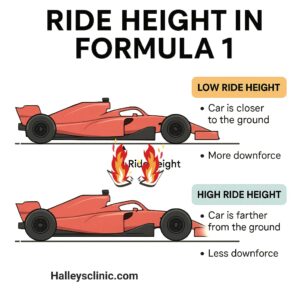Are F1 2026 Cars Lighter and Smaller? New regulation

- By Dr. AK Rana
When the FIA released the 2026 Formula 1 regulations back in 2024, one of the most talked-about changes was the size and weight reduction of the F1 2026 cars.
…
Gone are the days of the big, heavy beasts that dominated the grid. The 2026 machines will be leaner, more agile, and built for a new kind of racing.
But what exactly does this mean for the sport, the drivers, and the racing we love to watch?
Let’s break it all down.
…
2022 vs 2026: Size and Weight Comparison
The 2022 Formula 1 cars were the heaviest in the sport’s history, designed around ground effect aerodynamics and strict safety requirements.
Here’s how they compare to the 2026 models:
2022 Cars:
Minimum Weight: 798 kg
Length: ~3600 mm
Width: 2000 mm
Floor Width: Standard
F1 2026 cars:
Minimum Weight: 768 kg
Length: 3400 mm
Width: 1900 mm
Floor Width: Narrowed by 150 mm
…
That’s a 30 kg weight reduction, along with a shorter and narrower profile.
While it may not look massive on paper, in F1 terms, this is a substantial change that affects almost every part of the racing experience.
…
Why Lighter and Smaller Matters
Weight and size in Formula 1 influence just about everything: acceleration, braking, cornering, tyre wear, and agility.
Reducing both makes the cars more:
…
Nimble: A shorter wheelbase and reduced mass mean quicker direction changes. This lets drivers attack corners more aggressively and with more confidence.
Efficient: Lighter cars need less energy to accelerate and maintain speed, which is crucial in 2026, where battery power will play a much bigger role.
Raceable: A more compact car generates less turbulent air behind it. This “cleaner” air benefits the following car, helping drivers stay close through corners and increasing overtaking opportunities.
In simple terms: lighter and smaller cars = better racing.
…
The Physics Behind It
Let’s get a bit technical. Newton’s Second Law says: Force = mass x acceleration (F = ma).
…
When you reduce mass, the car accelerates faster with the same force.
Lighter cars also decelerate more efficiently, meaning shorter braking distances.
In corners, a lower mass means reduced inertia, making the car easier to rotate and more agile, especially in slow, twisty sections.
These changes may not seem dramatic, but over the course of a lap—or a full race—they can add up to a significant difference in both performance and race dynamics.
…
Impacts on Racing
So, what can we expect from these leaner machines when the lights go out in 2026?
More overtakes: smaller cars can follow closely, dive into tighter spaces, and capitalize on smaller mistakes.
Cleaner battles: Less “dirty air” means more predictable handling for the car behind, which encourages side-by-side action.
Driver confidence: A lighter car generally feels more connected to the track. Drivers can push harder, knowing the car will respond more directly.
…
The Challenge for Teams
This isn’t just a design trend—it’s an engineering mountain to climb.
With the 2026 power units relying more on electric energy, the cars need to carry larger batteries and complex energy recovery systems. That means teams will have to shed weight elsewhere just to hit the new 768 kg minimum.
Finding that balance without sacrificing performance or safety will require innovation in:
…
Materials (think more carbon fiber and lighter alloys)
Packaging (tighter engine and component placement)
Aerodynamics (smaller surface area, smarter airflow)
It’s a challenge, but also an opportunity for teams to gain an edge.
The reduction in size and weight for the 2026 Formula 1 cars isn’t just a cosmetic update—it’s a complete rethink of what modern F1 should be.
Stay tuned with Halleysclinic.com
Drop your thoughts in the comments
Reach out: halleysclinic@gmail.com
Don’t forget to follow our Instagram account https://www.instagram.com/halleysclinic
also read Why Are Penalties in the F1 Practice Becoming More Common?






1 thought on “Are F1 2026 Cars Lighter and Smaller? New regulation”